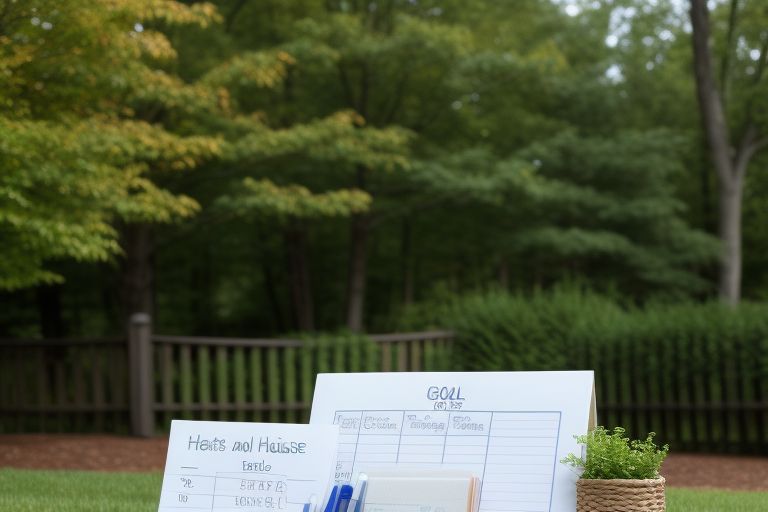Defining a realistic house saving goal is the primary stage towards your dream home. You need to know what goal you are working towards so that you can remain motivated and not be discouraged along the way. Read on if you wish to understand how you should go about setting reasonable house savings goals, regardless of whether you are saving up for your first home or planning to buy a bigger one.
In this post, we will discuss the key things that you should be doing to set a goal with respect to saving up for buying a house as well as working out how much you need. It gives practical advice on things like estimating costs, saving for your dream and so much more! With proper planning and financial discipline, you can reach your savings goal to finally buy a home.
Calculating Your House Budget

Steps Involved In Realistic House Savings Goal Calculation in Buying a House One of the initial steps you ought to make in establishing a reasonable house savings goal is to look for how much property you will afford. And that extra effort could be well worthwhile because – as I mentioned earlier – it can make a massive difference in your financial life if you either underestimate or overestimate. Knowing your budget is the biggest chunk of your savings plan that needs to be laid down first.
Calculate Your House Budget — First determine income and expenses. Most financial professionals will tell you to keep your monthly housing expenses (including taxes and insurance) under 30% of gross income. This will include the mortgage payment, real estate taxes, homeowner’s insurance and maintenance. Do a proper talley of what you can afford with your lifestyle, impending expenses, and other unknown potential changes in income.
After you determine the maximum house price, the next piece of preparation is to figure out how much you need for down payment. In general, most lenders will require you to put up 20% of the home purchase price as a down payment, but there are programs that allow for less. Remember: the more you have invested up front, the less your mortgage payment and overall interest will be over time.
Also Read More:
- 7 Simple Tricks to Pay Off Debt Faster

Paying down debt is tough, it can feel like a constant tug of war between […]
- What to Know Before Buying Used Items? – 10 Pro Tips

Used items or second-hand are a wonderful way to buy things for less but it […]
- 20 Smart Tips for Building an Emergency Fund

A rainy day fund is the foundation of financial security, providing a cushion that bails […]
- How Long Does It Take to Save for a House?

Purchasing a house is one of the most common financial milestones and it involves setting […]
- How to Budget Your Money Like a Pro

Budgeting is the foundation of financial health, but many find it difficult to keep a […]
Predicting How Much You Will Need To Pay
The very first step, before you even start saving, is to look at all the costs that may come with buying a home. With the right guidance and information about these other costs, you can avoid financial shocks when they appear. You also have to save for closing costs, which can be from 2%–5% of the home price.
You also have to think about home inspections, property taxes, homeowner’s insurance, moving costs and any repairs�/renovations you want to do after you move in. Tallying sum of these you will have a straightforward look at total money save for it. After buying your home, you might need to move in (ask your lease break fee) and many financial advisers suggest adding 3-6 months of living expenses in an emergency fund for any unexpected breakdowns.
How to Break-Down Your Saving Goal into Bite-Sized Parts
Now that we understand your total costs, it is time to get those saving goals broken down in way more detail. And this will help break it down into smaller concepts that are more achievable and won’t throw you off just a little when you finally finish.SHARE your thoughts over in the COMMUNITY group.
Growth of your accountTo begin with, first assess your total savings goal. This is your downpayment, closing costs and any other related fees. Additionally, you can find out how long until your home-buying timeframe to save. Take how much you want to save total and divide that by the number of months to set your goal for how much you need to save each month.
For instance, if you hope to have $50,000 for a house and plan to purchase in five years, then you would okay $833 per month. If that number feels intimidating, then find ways to reduce the amount you are spending or increase the amount you earn so that it is possible for your family to accomplish this goal. Turn it into monthly or even weekly savings goals to make the goal seem real and attainable.
10 Easy tactics to make houses for later with the aid of using saving
Here are 10 easy tactics to save money for buying a house in the future:
1. Set Up an Automated Savings Plan
- Automate monthly transfers to a dedicated house savings account. This ensures you consistently save a portion of your income without thinking about it.
2. Cut Unnecessary Subscriptions
- Review your recurring subscriptions (streaming, gym, magazines) and cancel those you don’t use often. Redirect the money saved towards your house fund.
3. Create a Budget and Stick to It
- Track your income and expenses to find areas where you can cut back. Allocate the extra funds to your savings.
4. Downsize Your Current Living Arrangements
- If possible, move to a smaller or cheaper rental to reduce your housing costs. Use the money saved on rent for your future home down payment.
5. Save Windfalls and Bonuses
- Allocate any extra income, such as tax refunds, work bonuses, or gift money, directly to your house savings account.
6. Eat Out Less and Cook at Home
- Limit dining out and coffee shop visits. Cooking meals at home can save significant money over time, helping you boost your savings.
7. Use Cashback and Rewards Programs
- Use cashback credit cards or shopping apps that offer rewards. Save the cashback rewards for your house fund instead of spending them.
8. Sell Unused Items
- Declutter your home by selling items you no longer need. Use platforms like eBay or Facebook Marketplace to earn extra cash for your house savings.
9. Reduce Utility Costs
- Be mindful of energy consumption by unplugging electronics, using energy-efficient appliances, and being smart with heating and cooling. The money saved on utilities can go into your savings.
10. Set Savings Goals with Timelines
- Set specific, realistic goals for how much you want to save each month and year. Track your progress and stay motivated by visualizing your future home.
This type of savings comes with advantages and disadvantages in each option If you want your savings to be safer and lower risk, a high-yield savings account is likely the way to go, while for more upside that comes with increased risk of capital loss, something like a brokerage account may make sense. Pick the savings tool that fits in better with your risk appetite and timeline.
Reducing Debt and Saving For a HouseMeasureSpec

Debt Management while Saving for a House can be Overwhelming But you must reach a balance between getting rid of debt and srvive the journey to your future home. Your credit score will also benefit when you lower your debt — and that can help you get a better rate on a mortgage loan whenever you decide to buy.
1) 50/30/20 Rule – A budgeting rule of thumb in which 50 percent of one’s income is spent on necessities, 30 percent on discretionary items and the remaining 20 percent going toward savings or paying off debt. This way, you can contribute to both debt and savings while fitting it into your budget so that not saving won’t be the reason you lost hope of buying a home in the future.
Focusing instead on paying down expensive debt, like credit card balances, may be a wise approach to rebuilding before committing to aggressive saving for homeownership. High-interest debt can bite big chunks out of your budget… and from you saving it for later on. After all your high-interest debts have been repaid, you should allocate more of your income into achieving the house savings goal.
Investing Windfalls in Savings Accounts

Windfalls, like tax refunds, bonuses or an unanticipated financial gift may dramatically increase the pace of your house savings. Instead of wasting that money on non-essential buys, you can just go ahead and redirect it straight to your savings targets. It helps you in a financial gain without altering your regular income or budget.
For instance, when you get a $2,000 tax refund back from the government put it directly into your house savings account. That lump sum adds up, and will be less you have to save each month to reach your goal.
Others might also spend some of any unexpected windfalls on enjoyable things, but save most of them. By employing this tactic, you are able to pay yourself back for the hard work that you have put in which will get you gratification without putting your future through it’s paces.
Progress Adjust my savings.
But once you set a target for how much to put away for that dream house, your eyes should be on the prize and track your goal of saving for a realistic home. Reviewing your savings plan periodically can help you make necessary adjustments to either your goal or contributions so that you stay on the path toward hitting your target.
Track your savings one way or another, it could be a mobile app that has a budgeting feature, or just an excel to mark how much you saved for the month and check where you are on your goal. You will be encouraged to remain firm after viewing the development you have had.
If you fall behind, reexamine your budget or schedule. Are there any small ways to save money? So, could you save more? Those little changes now are going to save you all that money in th future from not having financial stress
Making a Reserve for Those Unexpected expenses
So many people focus only on the down payment and closing costs when it comes to saving for a home. Nonetheless, you also should always have a fund for unplanned expenses. We all know life is full of surprises, building an emergency fund will help keep your house savings plan on course even when unexpected bills come up.
In general, you should have an emergency fund of 3-6 months living expenses that is entirely separate from any savings for a house. In this way, should you lose your job or have a medical emergency or other unexpected financial issue occur, you will not need to tap into your house fund.













